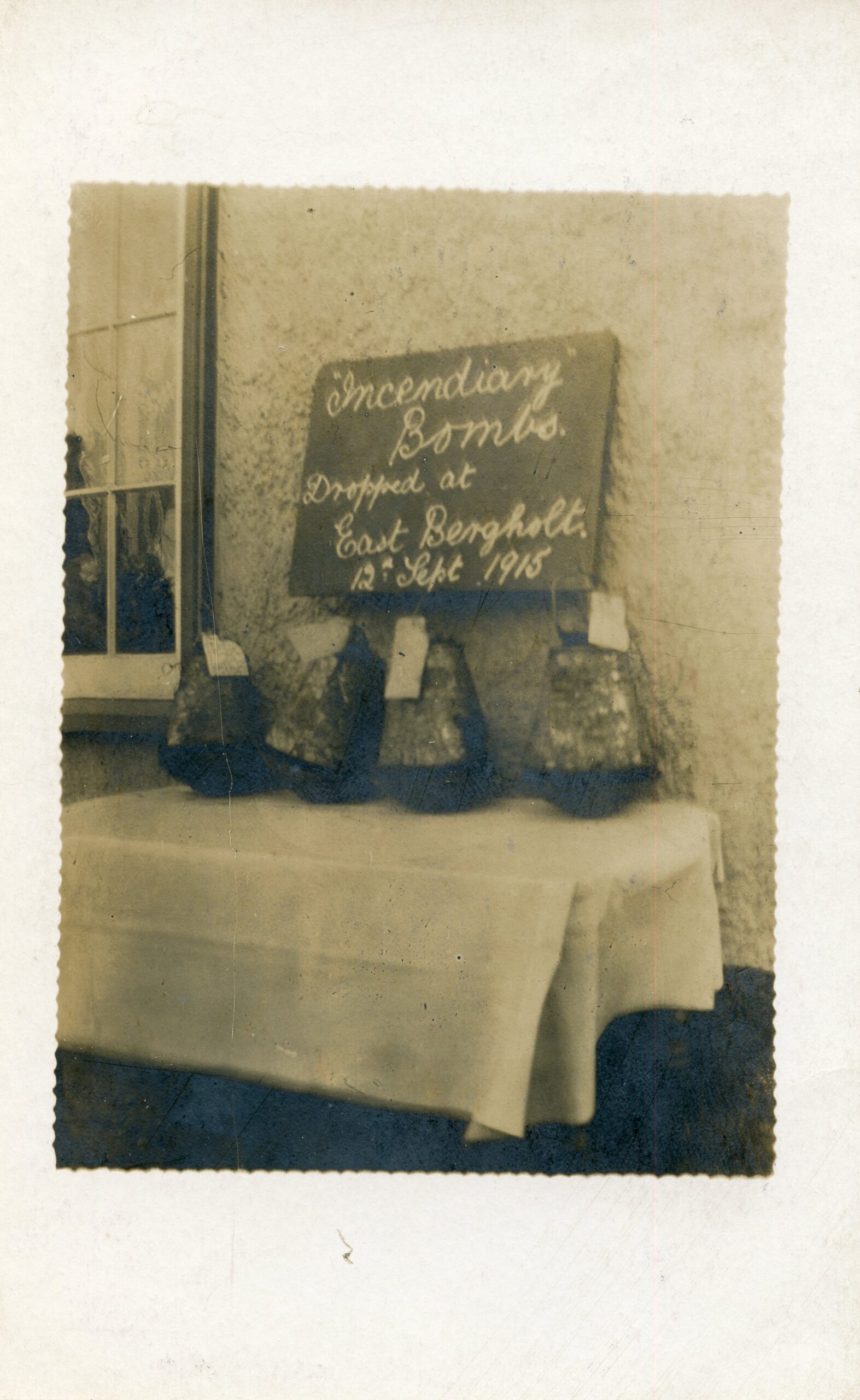The Village is Bombed
On the night of 12 September 1915, East Bergholt came under aerial attack for the first time in its history. A total of 8 bombs were dropped on the Parish, by a German Army Zeppelin, the LZ74. Fortunately, there were no casualties and no damage was caused.
- 3
- The bombing of East Bergholt on 12 September 1915
- 51.969964, 1.01284
Details
The bombing of the village does not appear to have been reported in the local newspapers of the time, and no record seems to exist of exactly where in the Parish that the bombs landed.
The comprehensive account below comes from the website “Zeppelins, Gothas and ‘Giants’ : The Story of Britain’s Forgotten Blitz 1914 – 1918” (https://www.iancastlezeppelin.co.uk/ ) hosted by Ian Castle, who is the author of several books on the Zeppelin raids against England., including “Zeppelin Onslaught – The Forgotten Blitz 1914 – 1915”.
“12/13 Sept. 1915
Bombed: Essex & Suffolk
On the night following the solo raid carried out of Army Zeppelin LZ 77, another single Army Zeppelin appeared over England. But, like the previous raid, it achieved nothing of significance.
Commanded by Hauptmann Friedrich George, LZ 74, making her second raid on England in five days, crossed the coast at Walton-on-the-Naze at about 10.45pm and followed a westerly course. There was much ground fog in places, which may be why George passed over Colchester at 11.05pm without attacking the town. Following a north-west course from there, LZ 74 dropped two high explosive (HE) bombs on the village of Wormingford in Essex, which fell harmlessly in a field. Moments later another HE bomb fell at the village of Mount Bures, again without causing injury or damage. From there she turned south but, when over Wakes Colne at about 11.15pm, she circled around to the north east. As LZ 74 approached Dedham at about 11.35pm, a mobile RNAS maxim gun opened fire from a hill near the church at Stratford St. Mary. The gun fired two belts of ammunition and about 30 rounds of incendiary bullets. Attracted by the firing, LZ 74 turned back and dropped 11 HE and five incendiary bombs, which fell on Hills Farm in Stratford St. Mary. A police report stated that bombs fell within 15, 25 and 75 yards of various houses but damage was limited to six panes of glass smashed and some fences broken. Some telegraph wires were also damaged.
Flying eastwards now, at about 11.45pm George took LZ 74 over East Bergholt, where he dropped another four HE bombs and four incendiaries; they caused no damage. Returning to a north east course, LZ 74 then passed over Ipswich without dropping bombs – the fog obscuring much – but at Rushmere Heath another RNAS mobile maxim detachment opened fire. In response, George released four HE bombs over Rushmere – one of which failed to explode – and began to take an evasive zig-zag course. Neither the maxim nor the bombs caused any damage.
Continuing on the same course, at Woodbridge at about 11.50pm, a third mobile RNAS maxim detachment engaged, but poor visibility restricted their efforts. At 12.05am, a fourth mobile maxim gun made a final ineffective attack on LZ 74 as it passed Aldeburgh, before she headed up the coast and headed out to sea near Southwold at 12.18am.
One defence aircraft was airborne from Eastchurch in Kent, forty miles to the south, too far away to have much chance in locating the raider.
Casualties: 0 killed, 0 injured
Damage: £8”
For many years after the event, one of the bombs was “on show” in the South Alcove of St. Mary’s Church, under a stone tablet which reportedly read:
“This bomb is one of 40
Dropped on our Parish
by a German Airship –
Sept. 12, 1915. Yet no one
was injured. Thank God.”
The number of 40 bombs being dropped on the village is incorrect.
Both the bomb and tablet were removed in 1948. to make way for the Village Memorial to those who died in the Second World War. Unfortunately, nobody now seems to know what happened to either the bomb or the tablet. 1 The LZ74 (Production Number LZ44) was a “P Class” Zeppelin, and had a crew of 19. It was 536 feet in length and 61 feet in diameter with a maximum speed of 57 miles per hour and a Service Ceiling of 11,600 feet.
The LZ74 carried out 2 attacks on England, but was wrecked on 8th October 1915 when it flew into a mountain in the Schnee Eifel range.
Acknowledgements
I am very grateful to Ian Castle, for his kind permission in allowing me to include the account of LZ74’s raid on the evening of 12/13 September 1915, taken from his website.
- 3
- The bombing of East Bergholt on 12 September 1915
- 51.969964, 1.01284

